Aquarium Conditioned
Desjardini Tang
Zebrasoma desjardini (SriLanka)
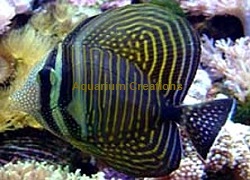
Click to view Desjardini and his beautiful reef!
Description:
Also called the Desjardini Tang, Red Sea Sailfin Tang, or the Desjardin's Surgeonfish. It is an active fish that requires plenty of swimming room. Very similar to it's cousin the Sailfin Tang, the Desjardini Sailfin Tang is much more ornate & as an adult will display a spectacular array of salmon-orange colored dots on it's belly as speckled freckled face & tail. The Juvenile Desjardini Sailfin Tangs tend to be more yellow instead of salmon-orange. Desjardini Sailfin Tangs are peaceful fish and will not bother other fish, coral or inverts in your tank. Desjardini Sailfin Tangs will only be aggressive to other tangs, especially other Zebrasoma tangs. To reduce aggression between tangs, it's a good idea to introduce them at the same time to your tank.
Tank Recommendations:
Desjardini Sailfin Tangs reach a maximum adult size of around 16 inches and when larger, they must be kept in tanks that are at least 180 gallons. Being very active during the day they need a large tank with plenty of room to swim about but will also need rocks/ corals to provide some cover and to sleep in at night. Having lots of live rock with algae on them is also great for tangs and helps reduce their aggression by having lots of available food so there isn't much competition for food. As they are primarily herbivores they ignore invertebrates, but lush natural algae growth will be greatly appreciated. Once they get acclimated and become accustom to aquarium foods they are quite hardy and long lived
Food and diet:
The Desjardini Sailfin Tangs are primarily herbivores. In the wild they feed mainly on leafy brown algae like Sargassum and Dictyota. Provide lots of algae, prepared frozen formulas containing algae or spirulina, and flakes. Japanese Nori or other seaweed can be adhered to the aquarium glass with a vegetable clip. It will also feed on some frozen brine and mysis shrimp. Some hobbyists also have great success with supplemental foods such as previously boiled or frozen zucchini, broccoli, spinach, and leaf lettuce. For the health of your fish it is always desirable to soak all fish food including algae with vitamins to help keep your fish healthier and less susceptible to disease. Another helpful tip is to soak your fishes food in garlic as well. Especially when adding new fish and whenever your notice ich or other disease in the aquarium. Garlic helps repel external parasites, such as ich, and boosts immunity in all your fish.
Level of Care:
Moderate
Acclimaton Time:
2+ hours
Reef Compatibility:
Great reef fish. Typically fares notably better in reef aquariums than in fish only tanks.
Approximate Purchase Size:
Small Juvenile 1" to 2" Small/Medium 2" to 3" Medium 3" to 4" Medium/Large: 4" to 5"; Large: 5" to 6"
Please Note:
The Juvenile Small Desjardini Tang may not yet have spots on their fins or their body yet, at this age they look very similar to the Sailfin Tang
|
Small Juvenile$74.99
Small/Medium $99.99
Medium $129.99
Medium/Large $159.99
Large $199.99
|
|
Aquarium Conditioned
Chevron Tang
Ctenochaetus hawaiiensis (Christmas Island)
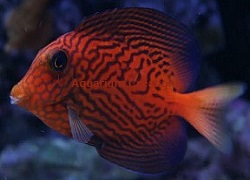
Click to view Chevron Tang
Description:
Juveniles are orange with blue lines on the body, while the dorsal and anal fins are blue. Adults are dark olive brown with thin pinstripes on the body. Adults are not often available. It is not an overly aggressive fish and will usually not bother fish tank-mates, with the possible exception of close relatives. It may be picked on by aggressive tangs. Provide this active fish with plenty of swimming room, as well one or two hiding places. Its teeth are adapted for browsing on diatoms (brown algae) off of hard substrates and its needs are easily met.
Tank Recommendations:
Chevron Tangs reach a maximum adult size of around 11 inches and when larger, they must be kept in tanks that are at least 180 gallons. Being very active during the day they need a large tank with plenty of room to swim about but will also need rocks/ corals to provide some cover and to sleep in at night. Having lots of live rock with algae on them is also great for tangs and helps reduce their aggression by having lots of available food so there isn't much competition for food. As they are primarily herbivores they ignore invertebrates, but lush natural algae growth will be greatly appreciated. Once they get acclimated and become accustom to aquarium foods they are quite hardy and long lived
Food and diet:
The Chevron Tang is primarily herbivores. In the wild they feed mainly on leafy brown algae like Sargassum and Dictyota. Provide lots of algae, prepared frozen formulas containing algae or spirulina, and flakes. Japanese Nori or other seaweed can be adhered to the aquarium glass with a vegetable clip. It will also feed on some frozen brine and mysis shrimp. Some hobbyists also have great success with supplemental foods such as previously boiled or frozen zucchini, broccoli, spinach, and leaf lettuce. For the health of your fish it is always desirable to soak all fish food including algae with vitamins to help keep your fish healthier and less susceptible to disease. Another helpful tip is to soak your fishes food in garlic as well. Especially when adding new fish and whenever your notice ich or other disease in the aquarium. Garlic helps repel external parasites, such as ich, and boosts immunity in all your fish.
Level of Care:
Moderate
Acclimaton Time:
2+ hours
Reef Compatibility:
Great reef fish. Typically fares notably better in reef aquariums than in fish only tanks.
Approximate Purchase Size:
Small; 1-1/2" to 2" Medium; 2" to 3" Large; 3" to 4"
|
Small $379.99
Medium $379.99
Large $379.99
|
|
Aquarium Conditioned
Purple Tang
Zebrasoma xanthurus (Red Sea)
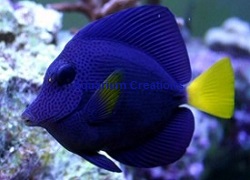 Click to view video of Purple Tang
Click to view video of Purple Tang
Description:
One of the most desired saltwater fish for the home aquarium, the Purple Tang was brought into the aquarist trade back in the 1960's, and originally collected only in the Red Sea, they have now been found in other locations such as the Gulf of Eden and in the Arabian Sea. Other names this beauty is known by is the Yellowtail Sailfin Tang, Yellowtail Surgeonfish, and Blue Surgeonfish. Adults in the wild will grow to about 10 inches, smaller of course in an aquarium.
Tank Recommendations:
Will do best in a reef aquarium with plenty of live rock and hiding places. Provide Purple tangs with plenty of open swimming room. In the wild they swim all over the reef grazing on algae. The Purple Tang is a great choice for aquariums of 120 gallons or more. In larger aquariums of 300 gallons or more, you can keep them in a small school provided they are added at the same time. Like other Tangs, Purple Tangs demonstrate territorial aggression towards their own species, or Tangs in general. When introducing a variety or a group of surgeon tangs to an aquarium, it is best to add them in groups to help avoid territorial disputes. Purple Tangs tend to be extra aggressive towards conspecifics with the same body shape such as the Yellow Tang and Scopas Tang. Again, this is where adding them together really makes a big difference.
Food and diet:
The Purple Tang will graze over the live rock in the aquarium eating algae. Try using a rubber-band to attach the algae to a small rock or pvc pipe and place it in the sand bed. Provide lots of algae, prepared frozen formulas containing algae or spirulina, and flakes. Japanese Nori or other seaweed can be adhered to the aquarium glass with a vegetable clip. It will also feed on some frozen brine and mysis shrimp. Some hobbyists also have great success with supplemental foods such as previously boiled or frozen zucchini, broccoli, spinach, and leaf lettuce. For the health of your fish it is always desirable to soak all fish food including algae with vitamins to help keep your fish healthier and less susceptible to disease. Another helpful tip is to soak your fishes food in garlic as well. Especially when adding new fish and whenever your notice ich or other disease in the aquarium. Garlic helps repel external parasites, such as ich, and boosts immunity in all your fish.
Level of Care:
Easy
Acclimaton Time:
2+ hours
Reef Compatibility:
Great hardy addition to any fish-only or reef aquarium system.
Approximate Purchase Size:
Small 1" to 2" Small/Medium 2" to 3" Medium 3" to 4" Medium/Large: 4" to 5"; Large: 5" to 6"
|
Small $349.99
Small/Medium $359.99
Medium $379.99
Medium/Large $439.99
Large $489.99
|
|
Aquarium Conditioned
Clown Tang
Acanthurus lineatus(Maldives)
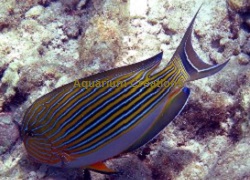
Click to view Aquarium Conditioned Clown Tang
Description:
The Clown Tang, is also called the Clown Surgeonfish, Lined Surgeonfish, and Blue-banded Surgeonfish. Love the colors on Clown Tangs with horizontal blue striping on a bright yellow to orange background. This beauty is very active and needs lots of unobstructed swimming room . Residing in highly-oxygenated areas of the ocean for aquarium success this must be duplicated by having large flowing pumps on the aquarium system which turns the aquarium water over very fast. Like most tangs, well-acclimated, comfortable specimens may be aggressive towards close relatives. It typically fares notably better in reef aquariums than in fish only tanks. Availability Notes: Small and medium are semi regularly available, larger specimens are seldom collected.
Tank Recommendations:
Clown Tangs are known to be a territorial species and may show aggressive tendencies as they mature; its recommended that they are housed singly in regards to conspecifics. Clown Tangs are very popular among more advanced hobbyists with large reef or FOWLR systems and are readily available within the hobby. With a maximum size of around fifteen inches, this energetic species will need a suitably large fish tank when fully grown, with a minimum recommendation of 180 gallons and it must be provided with plenty of open swimming space as well as a large amount of live rock for algae grazing as well as shelter and territory. As they are primarily herbivores they ignore invertebrates, but lush natural algae growth will be greatly appreciated. Once they get acclimated and become accustom to aquarium foods they are quite hardy and long lived
Food and diet:
Clown Tangs are herbivores and mainly eat marine algae and vegetable matter within their natural habitat, but they are known to accept most prepared, meaty food items. However, their diet should mainly consist of a variety of high quality and vitamin enriched marine algae preparations and fresh vegetable matter such as dried sheets of seaweed (also nori), romaine lettuce, broccoli, zucchini, spinach, and quality, Spirulina-based flake foods for herbivores. Although they may also graze on any filamentous algae within the aquarium, they should be fed at least twice a day and fresh vegetables should be offered 3 to 5 times per week. For the health of your fish it is always desirable to soak all fish food including algae with vitamins to help keep your fish healthier and less susceptible to disease. Another helpful tip is to soak your fishes food in garlic as well. Especially when adding new fish and whenever your notice ich or other disease in the aquarium. Garlic helps repel external parasites, such as ich, and boosts immunity in all your fish.
Level of Care:
Difficult, for the Expert Only
Acclimaton Time:
2+ hours
Reef Compatibility:
Great reef fish. Typically fares notably better in reef aquariums than in fish only tanks.
Approximate Purchase Size:
Small 1-1/2" to 2" Small/Medium 2" to 3" Medium 3" to 4" Medium/Large 4" to 5" Large 5" to 6" XLarge 6" to 8"
|
Small $59.99
Small/Medium $69.99
Medium $89.99
Medium/Large $159.99
Large $249.99
XLarge $299.99
|
|
Aquarium Conditioned
Sohal Tang
Acanthurus sohal(Red Sea)
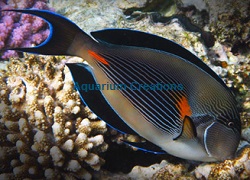
Click to View Reef with Red Sea Sohal Tang
Description:
The Sohal Tang or Red Sea Clown Tang is magnificent! While not an overly difficult fish to keep within the home aquarium, beyond their beauty they are beneficial in helping pick at hair algae. The Sohal Tang will spend their day picking at rock-work in search for hair algae to eat. A more beautiful fish is rarely seen. Notice the orange 'tang' on the caudal peduncle just in front of the tailfin. Also the fluorescent blue fringe on the edges of the fins. The Sohal Tang or Red Sea Clown Tang is from the Red Sea and the Western Indian ocean. Although fish from the Red Sea are generally more expensive, they are always net caught and are handled with more care, which gives them a much better survival rate.
Tank Recommendations:
With a maximum size of around sixteen inches, this energetic species will need a suitably large fish tank when full grown, with a recommended size being 250 gallon. Sohal Tangs tend to vary from semi-aggressive to aggressive in nature, thus they should only be kept with other fish species that can tolerate living with other semi-aggressive to aggressive tank mates.
An ideal aquarium setup for a Sohal Tang would provide them with a long aquarium (6 feet or larger) with plenty of live rock for grazing and open swimming areas. Their laterally compressed body and large size means that they swim very swiftly, which makes them most suitable for larger reef and FOWLR aquariums. Medium to strong water currents and large open swimming areas are very important in order to provide the Sohal Tang an environment that satisfies their basic needs. Properly housed and cared for Sohal Tangs can live a long life of up to 15 years of age within the aquarium environment.
Food and diet:
Sohal Tangs are a herbivorous species whose diet should consist primarily of marine algae, seaweed and plant material. They will also feed on meaty foods fed to other fish housed in the aquarium, but the vast majority of their diet should come from plant matter. Sohal Tangs are also natural grazers that prefer to feed in smaller amounts throughout the day. The best approach for this species is to provide them seaweed, romaine lettuce, green leaf lettuce or similar items that they can graze on throughout the day. They will also graze on naturally occurring algae growth within the aquarium and will feed on commercial foods designed for both herbivores and omnivores. For the health of your fish it is always desirable to soak all fish food including algae with vitamins to help keep your fish healthier and less susceptible to disease. Another helpful tip is to soak your fishes food in garlic as well. Especially when adding new fish and whenever your notice ich or other disease in the aquarium. Garlic helps repel external parasites, such as ich, and boosts immunity in all your fish.
Level of Care:
Moderate
Acclimaton Time:
2+ hours
Reef Compatibility:
Great reef or Fowlr aquarium fish.
Approximate Purchase Size:
Small: 1-1/2" to 2" Small/Medium 2" to 3" Medium: 3" to 4" Medium/Large: 4" to 5" Large: 5" to 6" XLarge 6" to 8"
|
Small $239.99
Small/Medium $249.99
Medium $299.99
Medium/Large $379.99
Large $479.99
XLarge $559.99
|
|
Aquarium Conditioned
Powder Brown Tang
Acanthurus nigricans
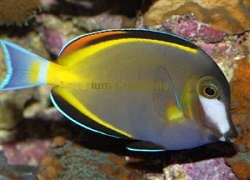
Click for Video of Powder Brown Tang in Nice Reef Tank
Description:
The Powder Brown Tang, also known as the Powder Brown Surgeonfish, Japan Surgeonfish, and White-faced Surgeonfish, is a very active and stunning surgeonfish. Powder Brown Tangs have a round body that is mostly brown with a black fins and strong yellow and red markings. The dorsal fin also has an orange stripe present. The tail is blue with a yellow vertical bar. Yellow striping runs along the body, against the anal and dorsal fins, forming a wishbone-shaped marking. The Powder Brown Tang is widely distributed across the Indo-West Pacific; it can be found in the waters of southern Japan, Taiwan; Indonesia, the Philippines, the Hawaiian Islands, and New Caledonia. Its name, japonicus, refers to the fact that it's often found off the coast of Japan. A popular fish, but one that requires careful maintenance, the Powder Brown Tang is best housed as the only Tang present in an aquarium. The Powder Brown does best in an aquarium with plenty of potential "houses" or places to duck into when it feels threatened. Although the similar Goldrim or Whitecheek Tang (Acanthurus nigricans) is also delicate, it is somewhat more durable. Powder Brown Tangs are mostly peaceful fish and shouldn't bother other fish, coral or inverts in your tank. This makes them a great choice for reef tanks or Fowlr systems.
Tank Recommendations:
Powder Brown Tangs reach a maximum adult size of around 8 inches in the wild, slightly smaller in the aquarium. Recommended aquarium size is 100 gallons or larger. Being very active during the day they need a tank with plenty of room to swim about but will also need rock to provide some cover and to sleep in at night. Having lots of live rock with algae on is also great for all tangs and helps reduce their aggression by having lots of available food so there isn't much competition for food. Powder Brown Tang is a relatively peaceful Surgeonfish and can be kept in a reef or community tank provided the tank is large enough (they need a great deal of space to move, and can be very messy with their food). This species can be a good tank-mate for a wide range of fish or any size, even with smaller semi-aggressive fish; some potential tankmates include Clownfish, Gobies, Blenny, Anthias, and Fairy Wrasses. It is a very passive fish that will have trouble with other aggressive tangs. Keep only one per tank.
Food and diet:
Powder Brown Tangs are a herbivorous species whose diet should consist primarily of marine algae, seaweed and plant material. They will also feed on meaty foods fed to other fish housed in the aquarium, but the vast majority of their diet should come from plant matter. Sohal Tangs are also natural grazers that prefer to feed in smaller amounts throughout the day. The best approach for this species is to provide them seaweed, romaine lettuce, green leaf lettuce or similar items that they can graze on throughout the day. They will also graze on naturally occurring algae growth within the aquarium and will feed on commercial foods designed for both herbivores and omnivores. For the health of your fish it is always desirable to soak all fish food including algae with vitamins to help keep your fish healthier and less susceptible to disease. Another helpful tip is to soak your fishes food in garlic as well. Especially when adding new fish and whenever your notice ich or other disease in the aquarium. Garlic helps repel external parasites, such as ich, and boosts immunity in all your fish.
Level of Care:
Moderate
Acclimaton Time:
2+ hours
Reef Compatibility:
Great addition to any fish-only or reef aquarium system.
Approximate Purchase Size:
Small: 2" to 2 1/2" Small/Medium: 2 1/2" to 3" Medium: 3" to 4" Medium/Large: 4" to 5" Large: 5" to 6"
|
Small $119.99
Small/Medium $124.99
Medium $139.99
Medium/Large $179.99
Large $249.99
|
|



 Click to view video of Purple Tang
Click to view video of Purple Tang


